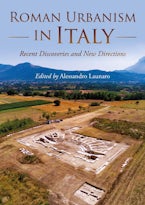Although a large number of cemeteries have been explored in Roman Britain they have never been seen as central to the study of the province. This collection of twenty-eight papers, from a symposium held at the University of Durham in 1997, explores different approaches to examine the contribution that cemeteries can make to our wider understanding of Roman society. The papers are grouped under five headings: The reconstruction of mortuary rituals; Burial and social status; The dead in the landscape; Burial and ethnicity and society; Religion and Burial in late Roman Britain and Italy.
Preface (M.Millet) vii
Abstracts, Zusammenfassungen, Resumes ix
List of Contributors xxiii
THE RECONSTRUCTION OF MORTUARY RITUALS
1. Burial, society and context in the provincial Roman worls (J.Pearce) p.1
Introduction p.13
2. Ritual, sequence, and structure in Late Iron Age mortuary practices in north-west Europe (A.p. Fitxpatrick) p.15
3. Reconstructing funerary rituals: the evidence of ustrina and related archaeological structures (M.Polfer) p.30
4. Phoenix rising: aspects of cremation in Roman Britain (J. McKinley) p.38
5. Functional and conceptual archaeobotanical data from Roman cremations (A. Kreuz) p.45
6. Pottery assemblages in Gallo-Roman cemteries (M. Tuffreau-Libre) p.52
BURIAL AND SOCIAL STATUS
Introduction p.61
7.Mors immatura in he Roman world - a mirror of society and tradition (S. Martin-Kilcher) p.63
8. Portrait figures on sephulchral altars of Roman liberti: evidence of Romanization or assimilation of attributes characterizing higher social strata? (D. Dexheimer) p.78
9. High status burials in roman Britain (1st-3rd centuries AD) - potential of interpretation (M. Struck) p. 85
10. Funerary rites in Verulamium during the early Roman period (R. Niblett) p.97
11. Biology and burial practices from the end of the first century AD to the beginning of the fifth century AD: the rurla necropolis of Chantambre (essonne, France) (P. Murail and L. Girard) p.105
12. A Roman cemetery in the eastern Civitas Treverorum. Preliminary report on the excavations in Wadern-Oberlosten in Northwest Saarland (Germany) (A. Abegg-Wigg) p.112
13.An elite funerary enclosure in the centre of the villa of Biberist-Spitalhof (Switzerland) - a case study (C. Schucany) p.118
THE DEAD IN THE LANDSCAPE
Introduction p.125
14. Putting the dead in their place: burial location in Roman Britain (S. Esmonde Cleary) p.127
15. Continuity of prehistoric burial sites in the Roman landscape of Sandy Flanders (F. Vermeulen and J. Bourgeois) p. 143
16. The living and the dead: approches to landscape around Lyons (L. Tranoy) p.162
17. Burial in Asia Minor during the Imperial period, with particular reference to Cilicia and Cappadocia (M. Spanu) p.169
BURIAL AND ETHNICITY
Introduction p.179
18. Early Roman graves in Southern Bavaria: a review (P. Fasold) p. 181
19. Early Roman graves in Cologne (M. Riedel) p. 192
20. Connection between funerary rites and ethnic groups in the cemeteries of north-eastern Pannonia (J. Topal) p.197
21. Romanization and ethnic elements in burial practice in the southern part of Pannonia Inferior and Moesia Superior) A. Jovanovic) p.204
SOCIETY, RELIGION AND BURIAL IN LATE ROMAN BRITAIN AND ITALY
Introduction p.215
22. Putting Late Roman burial practice (from Britain) in context (L. Quensel-von-Kalben)
23. Gender imbalances in Romano-British cemetery populations: a re-evaluation of the evidence (C. Davison) p.231
24. Glass vessels as grave goods and grave ornaments in the catacombs of Rome (P. De Santis) p.238
25. Clothing in burial practice in Italy in the early Christian period (R. Martorelli) p. 244
26. Amulet and grave in Late Antiquity: some examples from Roman cemeteries (D. Nuzzo) p.249
27. Funerary equipment from the circiforme basilica by the Via Ardeatina, Rome (P. del Moro) p.256
28. Intra-mural burials at Rome between the 5th and 7th centuries AD (R, Meneghini and R. Santangeli Valenzani) p. 263
Afterword (R.Reece) p.270












